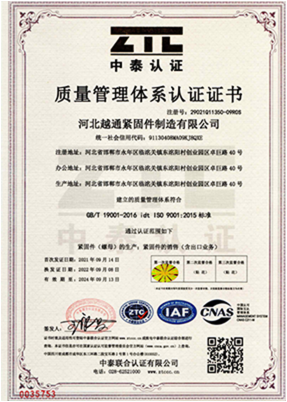Aug . 15, 2024 15:39 Back to list
Exploring the Applications and Benefits of Metal Rods and Screws in Construction and Engineering
The Versatility of Metal Rod Screws An In-Depth Look
Metal rod screws are an essential component in various industries, ranging from construction and automotive to electronics and furniture manufacturing. These fasteners play a crucial role in assembling and securing different materials, thanks to their robust construction and reliable performance. In this article, we will explore the different types, materials, applications, and advantages of metal rod screws.
Types of Metal Rod Screws
Metal rod screws come in various types designed for specific applications. The most common types include
1. Hex Head Screws Characterized by their hexagonal heads, these screws require a wrench for tightening and loosening. They are commonly used in construction and heavy industries where high torque is necessary.
2. Socket Head Cap Screws Featuring a cylindrical head with a hexagon socket, these screws are used in applications where space is limited, as they can be driven with an Allen wrench. They provide a strong grip and are often found in machinery and automotive parts.
3. Machine Screws These screws are designed to be used with a nut or tapped hole and are available in various head styles, such as flat, round, or pan. Machine screws are versatile and used in a wide range of applications, including electronics and appliances.
4. Set Screws These screws do not have a head and are used to secure one object against another, typically in rotating applications. Set screws are commonly found in gears, pulleys, and other mechanical assemblies.
Materials Used
Metal rod screws are typically made from a range of materials, each offering distinct characteristics
- Carbon Steel Known for its strength and durability, carbon steel screws are widely used in construction and automotive industries. They can be plated or coated for corrosion resistance.
- Stainless Steel Renowned for its corrosion resistance, stainless steel screws are ideal for applications in marine environments or outdoor settings. They maintain their strength and appearance even when exposed to harsh conditions.
metal rod screw

- Alloy Steel Offering enhanced strength and toughness, alloy steel screws are commonly used in high-stress applications, such as those found in heavy machinery and aerospace industries.
- Brass and Bronze While not as common for structural applications, brass and bronze screws are valued for their aesthetic appeal and resistance to corrosion, making them popular for decorative items and marine applications.
Applications
Metal rod screws are utilized in a myriad of applications due to their versatility and reliability. In construction, they are used to secure structural components, ensuring the stability and integrity of buildings. In the automotive industry, these screws play a vital role in assembling various parts, from engines to chassis. Additionally, metal rod screws are essential in the manufacturing of consumer electronics, where precise assembly is crucial for functionality.
Advantages
The use of metal rod screws offers numerous advantages
1. Strength Metal screws provide superior load-bearing capabilities compared to other types of fasteners, allowing for secure assemblies that can withstand significant stress.
2. Longevity Due to their durable materials, metal rod screws have a long lifespan, making them a cost-effective choice for both manufacturers and consumers.
3. Versatility With various types and sizes available, metal rod screws can be used in a wide range of applications, making them a staple in many industries.
4. Easy to Use Most metal rod screws are straightforward to install and remove, which facilitates maintenance and repairs across various projects.
In conclusion, metal rod screws are indispensable components in modern manufacturing and construction. Their strength, versatility, and reliability make them a go-to choice for various applications, ensuring that structures, machinery, and products are securely assembled and functional. As industries continue to evolve, the significance of these fasteners will undoubtedly remain paramount in driving innovation and efficiency.


